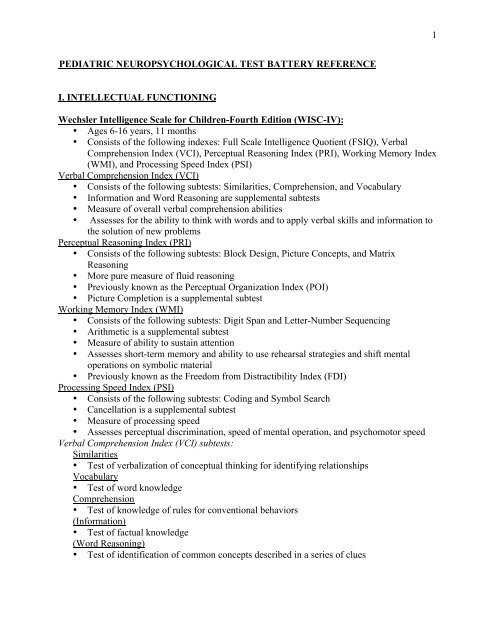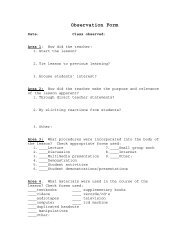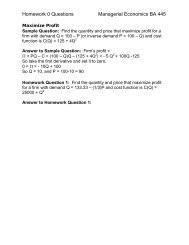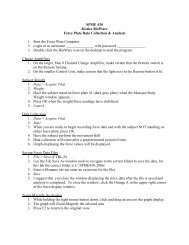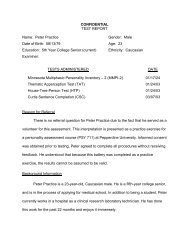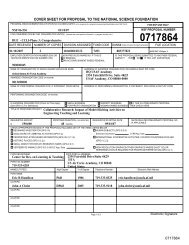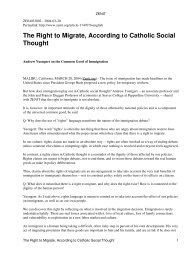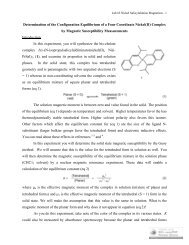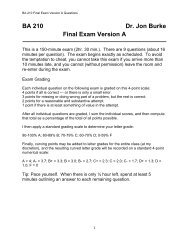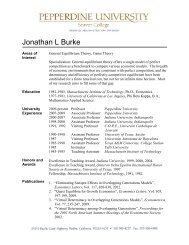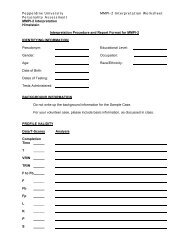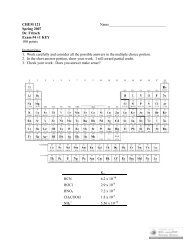pediatric neuropsychological test battery reference
pediatric neuropsychological test battery reference
pediatric neuropsychological test battery reference
Create successful ePaper yourself
Turn your PDF publications into a flip-book with our unique Google optimized e-Paper software.
1PEDIATRIC NEUROPSYCHOLOGICAL TEST BATTERY REFERENCEI. INTELLECTUAL FUNCTIONINGWechsler Intelligence Scale for Children-Fourth Edition (WISC-IV):• Ages 6-16 years, 11 months• Consists of the following indexes: Full Scale Intelligence Quotient (FSIQ), VerbalComprehension Index (VCI), Perceptual Reasoning Index (PRI), Working Memory Index(WMI), and Processing Speed Index (PSI)Verbal Comprehension Index (VCI)• Consists of the following sub<strong>test</strong>s: Similarities, Comprehension, and Vocabulary• Information and Word Reasoning are supplemental sub<strong>test</strong>s• Measure of overall verbal comprehension abilities• Assesses for the ability to think with words and to apply verbal skills and information tothe solution of new problemsPerceptual Reasoning Index (PRI)• Consists of the following sub<strong>test</strong>s: Block Design, Picture Concepts, and MatrixReasoning• More pure measure of fluid reasoning• Previously known as the Perceptual Organization Index (POI)• Picture Completion is a supplemental sub<strong>test</strong>Working Memory Index (WMI)• Consists of the following sub<strong>test</strong>s: Digit Span and Letter-Number Sequencing• Arithmetic is a supplemental sub<strong>test</strong>• Measure of ability to sustain attention• Assesses short-term memory and ability to use rehearsal strategies and shift mentaloperations on symbolic material• Previously known as the Freedom from Distractibility Index (FDI)Processing Speed Index (PSI)• Consists of the following sub<strong>test</strong>s: Coding and Symbol Search• Cancellation is a supplemental sub<strong>test</strong>• Measure of processing speed• Assesses perceptual discrimination, speed of mental operation, and psychomotor speedVerbal Comprehension Index (VCI) sub<strong>test</strong>s:Similarities• Test of verbalization of conceptual thinking for identifying relationshipsVocabulary• Test of word knowledgeComprehension• Test of knowledge of rules for conventional behaviors(Information)• Test of factual knowledge(Word Reasoning)• Test of identification of common concepts described in a series of clues
2Perceptual Reasoning Index (PRI) sub<strong>test</strong>s:Block Design• Test of visual-motor integration and spatial orientation with blocksPicture Concepts• Test of higher order associative reasoning skills with picturesMatrix Reasoning• Test of nonverbal reasoning ability for perceptual discrimination(Picture Completion)• Test of ability to differentiate between essential and nonessential detailsWorking Memory Index (WMI) sub<strong>test</strong>s:Digit Span• Test of rote short-term auditory memory for numbersLetter-Number Sequencing• Test of short-term auditory memory of letters and numbersArithmetic)• Test of application of reasoning skills for solving mathematical problemsProcessing Speed Index (PSI) sub<strong>test</strong>s:Coding• Measure of visual motor speed and dexteritySymbol Search• Assesses perceptual discrimination and processing speed abilities(Cancellation)• Test of ability to scan both a random and structured arrangement of picturesWechsler Intelligence Scale for Children-Third Edition (WISC-III):• Ages 6-16 years, 11 months• Following indexes: Full Scale Intelligence Quotient (FSIQ), Verbal Intelligence Quotient(VIQ), Performance Intelligence Quotient (PIQ), Verbal Comprehension Index (VCI),Perceptual Organization Index (POI), Freedom from Distractibility Index (FDI), andProcessing Speed Index (PSI)Verbal Comprehension Index (VCI)• Consists of the following sub<strong>test</strong>s: Information, Similarities, Vocabulary, andComprehension• Measure of overall verbal comprehension abilities• Assesses for the ability to think with words and to apply verbal skills and information tothe solution of new problemsPerceptual Organization Index (POI)• Consists of the following sub<strong>test</strong>s: Picture Completion, Picture Arrangement, BlockDesign, and Object Assembly• Measure of overall perceptual organization skills• Assesses for ability to think in terms of visual images and manipulate them with fluency,flexibility, and relative speed• Notes the ability to interpret or organize visually perceived material within a time limit
Freedom from Distractibility Index (FDI)• Consists of the following sub<strong>test</strong>s: Arithmetic and Digit Span• Measure of ability to sustain attention• Assesses short-term memory and ability to use rehearsal strategies and shift mentaloperations on symbolic materialProcessing Speed Index (PSI)• Consists of the following sub<strong>test</strong>s: Coding and Symbol Search• Measure of processing speed• Assesses perceptual discrimination, speed of mental operation, and psychomotor speedVerbal Intelligence Quotient (VIQ) sub<strong>test</strong>s:Information• Test of factual knowledgeSimilarities• Test of verbalization of conceptual thinking for identifying relationshipsArithmetic• Test of application of reasoning skills for solving mathematical problemsVocabulary• Test of word knowledgeComprehension• Test of knowledge of rules for conventional behaviors(Digit Span)• Test of rote short-term auditory memory for numbersPerformance Intellectual Quotient (PIQ) sub<strong>test</strong>s:Picture Completion• Measure of ability to differentiate between essential and nonessential detailsCoding• Measure of visual motor speed and dexterityPicture Arrangement• Test of sequential thought processes for ability to infer causal relationshipsBlock Design• Test of visual-motor integration and spatial orientation with blocksObject Assembly• Test of ability to synthesize concrete parts into meaningful wholes(Symbol Search)• Test of perceptual discrimination and processing speed abilities(Mazes)• Test of visual-motor and perceptual organization3
Woodcock Johnson Psychoeducational Battery-Third Edition: Test of Cognitive Abilities(WJ-III: Cognitive)• Measures different aspects of cognitive ability• Contains 20 <strong>test</strong>s• Ages 2-90• Clusters on acquired knowledge, thinking ability, and cognitive efficiency• Definition of measured abilities by each <strong>test</strong>/cluster are based on the Cattell-Horn-Carol(CHC) theory of cognitive abilities (i.e., Gf-Gc theory and the three-stratum theory inwhich Stratum III represents a general factor (g), Stratum II, the broad abilities (e.g., Gf,Gc), and Stratum I, the many narrow abilitiesCluster of Verbal Ability-Standard Scale• Consists of Test 1: Verbal Comprehension, including all 4 of its sub<strong>test</strong>s• Measure of language developmentCluster of Verbal Ability-Extended Scale• Consists of Test 1: Verbal Comprehension and Test 11: General Information• Represents a broad category of language-based acquired knowledge and the ability tocommunicate that knowledgeCluster of Thinking Ability-Standard Scale• Consists of Test 2: Visual-Auditory Learning, Test 3: Spatial Relations, Test 4: SoundBlending, and Test 5: Concept Formation• Represents a sampling of different thinking processes that may be invoked wheninformation in short-term memory can’t be automatically processedCluster of Thinking Ability-Extended Scale• Consists of Test 2: Visual-Auditory Learning, Test 3: Spatial Relations, Test 4: SoundBlending, Test 5: Concept Formation, Test 12: Retrieval Fluency, Test 13: PictureRecognition, Test 14: Auditory Attention, and Test 15: Analysis-Synthesis• A broad representation of the following four thinking abilities: long-term retrieval (Glr),visual-spatial thinking (Gv), auditory processing (Ga), and fluid reasoning (Gf)Cluster of Cognitive Efficiency-Standard Scale• Includes Test 6: Visual Matching and Test 7: Numbers Reversed• Represents the capacity of the cognitive system to process information automaticallyCluster of Cognitive Efficiency-Extended Scale• Includes Test 6: Visual Matching, Test 7: Numbers Reversed, Test 16: Decision Speed,and Test 17: Memory for Words• Represents two types of cognitive processing, processing speed (Gs) and short-termmemory (Gsm)Cluster of Comprehension-Knowledge• Includes Test 1: Verbal Comprehension and Test 11: General Information• Represents crystallized intelligence, which includes the breadth and depth of acquiredknowledge, ability to verbally communicate knowledge, and ability to reason usingpreviously learned experiencesCluster of Long-Term Retrieval• Includes Test 2: Visual-Auditory Learning and Test 12: Retrieval Fluency• Represents the ability to store information and fluently retrieve it later via thinking4
Cluster of Visual-Spatial Thinking• Includes Test 3: Spatial Relations and Test 13: Picture Recognition• Represents the ability to perceive, analyze, synthesize, and think with visual patterns,including the ability to store and recall visual representationsCluster of Auditory Processing• Includes Test 4: Sound Blending and Test 14: Auditory Attention• Represents the ability to analyze, synthesize, and discriminate auditory stimuli, includingthe ability to process and discriminate speech sounds that may be presented underdistorted conditionsCluster of Fluid Reasoning• Includes Test 5: Concept Formation and Test 15: Analysis-Synthesis• Represents the broad thinking ability of reasoning, forming concepts, and solvingproblems using unfamiliar information or novel proceduresCluster of Processing Speed• Includes Test 6: Visual Matching and Test 16: Decision Speed• Represents the ability to perform automatic cognitive tasks, particularly measured underpressure to maintain focused attentionCluster of Short-Term Memory• Includes Test 7: Numbers Reversed and Test 17: Memory for Words• Represents the ability to apprehend and hold information in immediate awareness andthen use it within a few secondsCluster of Phonemic Awareness• Includes Test 4: Sound Blending and Test 8: Incomplete Words• Represents the knowledge and skills related to analyzing and synthesizing speech soundsCluster of Working Memory• Includes Test 7: Numbers Reversed and Test 9: Auditory Working Memory• Represents the ability to hold information in immediate awareness while performing amental operation on the informationCluster of Broad Attention• Includes Test 7: Numbers Reversed, Test 9: Auditory Working Memory, Test 14:Auditory Attention, and Test 20: Pair Cancellation• Represents the complex construct of attention, which consists of focused or selectiveattention, vigilance or sustained attention, divided attention, and attentional capacity orworking memoryCluster of Cognitive Fluency• Consists of Test 12: Retrieval Fluency and Test 16: Decision Speed• Represent the ease and speed of performing cognitive tasksCluster of Executive Processes• Includes Test 5: Concept Formation, Test 19: Planning, and Test 20: Pair Cancellation• Represents three aspects of executive functioning: strategic planning, proactiveinterference control, and the ability to repeatedly shift one’s mental setCluster of Delayed Recall• Includes Test 10: Visual-Auditory Learning-Delayed and Test 12: Story Recall• Represents the ability to both recall and relearn associations previously learned5
Cluster of Knowledge• Includes Test 11: General Information and Test 19: Academic Knowledge• Represents general information and curricular knowledgeVerbal Comprehension• Includes the following four sub<strong>test</strong>s: Picture Vocabulary (lexical knowledge), Synonyms(vocabulary knowledge), Antonyms (vocabulary knowledge), and Verbal Analogies(reasoning using lexical knowledge) to measure different aspects of languagedevelopment• Measure of acquired knowledgeVisual-Auditory Learning• Test of long-term storage and retrieval involving associative and meaningful memory• Asked to learn and recall rebuses (i.e., pictographic representations of words)Spatial Relations• Test of visual-spatial thinking• Requires identification of the two or three pieces that form a complete target shapeSound Blending• Test of auditory processing <strong>test</strong> of phonetic coding• Asked to synthesize language sounds after listening to a series of syllables or phonemesConcept Formation• Test of fluid reasoning and executive processing consisting of a controlled-learning taskinvolving categorical reasoning based on principles of inductive knowledge• Requires the derivation of rules for each item upon presentation of a complete stimulusset and examiner feedbackVisual Matching• Test of processing speed that is perceptual• Visual Matching 1 is used for preschool children and individuals with impaired cognitivefunctioning requires pointing to the two matching shapes in a row of 4-5 shapes• Visual Matching 2 is used for individuals above a maturational age of 5 and asked for thelocations and circling of the two identical numbers in a row of 6 numbersNumbers Reversed• Test of short-term memory as well as attentional capacity and working memory• Requires the retaining of a span of numbers in immediate awareness while performing ametal operation on it by reversing its sequenceIncomplete Words• Test of auditory processing, including auditory analysis and auditory closure, aspects ofphonemic awareness, and phonetic coding• Asks for the identification of the complete word upon hearing a word with missingphonemes from an audio recordingAuditory Working Memory• Test of short-term auditory memory span, including working memory and dividedattention• Requires the reordering of information, repeating objects then digits in sequential orderupon the presentation of a series containing words and digits6
Visual-Auditory Learning-Delayed• Test of long-term retrieval-especially aspects of associative and meaningful memory• Asked to relearn the associations made in Test 2: Visual-Auditory Learning 30 minutes to8 days later to identify the ease of relearningGeneral Information• Test of comprehension-knowledge-especially verbal• Consists of the following two sub<strong>test</strong>s: “Where you find…(an object)?” and “What wouldyou do with…(an object)?”Retrieval Fluency• Test of long-term retrieval fluency from stored knowledge• Requires the naming of as many examples from a given category within one minutePicture Recognition• Test of visual memory of objects or pictures as part of visual-spatial thinking• Asks to recognize a subset of previously presented pictures within a field of distractingpicturesAuditory Attention• Test of speech-sound discrimination, or the ability to overcome the effects of auditorydistortion or masking in understanding oral language• Requires the pointing to the correct picture for a word upon listening to a word whileseeing four picturesAnalysis-Synthesis• Test of fluid reasoning involving sequential (deductive) reasoning• Asks to perform increasingly complex procedures by giving instructions on performanceand feedback on correctness• Involved learning of a miniature system of mathematics and uses symbolic formationsfrom chemistry and logicDecision Speed• Test of processing speed-the ability to make conceptual decisions quickly• Requires the quick location of two pictures that are conceptually alikeMemory for Words• Test of short-term auditory memory span• Asks to repeat lists of unrelated words in the correct sequenceRapid Picture Naming• Test of cognitive fluency and processing speed• Requires speedy direct recall of information from acquired knowledgePlanning• Test of executive processing of mental control process involved in determining, selecting,and applying solutions to problems using forethought• Asks to trace a pattern without removing the pencil from the paper or retracting any linesPair Cancellation• Test of executive processing, attention/concentration, and processing speed abilities• Requires the location and marking of a repeated pattern as quickly as possible7
8II. ACHIEVEMENTWoodcock-Johnson Psychoeducational Battery-Third Edition: Test of Achievement (WJ-III: Achievement)• Individually administered <strong>test</strong> designed to assess academic achievement in reading,mathematics, written language, and general knowledge• Ages 2-90+ years• Conormed with WJ-III Cognitive to allow comparisons of ability versus achievement• Standard <strong>battery</strong> includes the following sub<strong>test</strong>s: Letter-Word Identification, ReadingFluency, Passage Comprehension, Spelling, Writing Fluency, Writing Samples,Understanding Directions, Story Recall and Story Recall-Delayed, Calculation, MathFluency, and Applied Problems• Academic Achievement clusters: Broad Reading, Broad Mathematics, Broad OralLanguage, and Broad Written Language• Other sub<strong>test</strong>s are: Academic Knowledge, Phoneme/Grapheme Knowledge, AcademicSkills, Academic Fluency, and Academic Application• Extended Battery consists of the following sub<strong>test</strong>s: Word Attack, Picture Vocabulary,Oral Comprehension, Editing, Reading Vocabulary, Quantitative Concepts, AcademicKnowledge, Spelling of Sounds, Sound Awareness, Punctuation, and Capitalization• Oral language <strong>test</strong>s, each Basic Achievement cluster has a basic skills <strong>test</strong>, fluency <strong>test</strong>,and application <strong>test</strong>• Obtain a Total Achievement ScoreCluster of Broad Reading• Consists of Test 1: Letter-Word Identification, Test 2: Reading Fluency, and Test 9:Passage Comprehension• Provides a comprehensive measure of reading achievement including reading decoding,reading speed, and the ability to comprehend connected discourse while readingCluster of Basic Reading Skills• Consists of Test 1: Letter-Word Identification and Test 13: Word Attack• Provides a measure of basic reading skills and measures sight vocabulary, phonics, andstructural analysisCluster of Reading Comprehension• Consists of Test 9: Passage Comprehension and Test 17: Reading Vocabulary• Provides a measure of reading comprehension skills, vocabulary, and reasoningCluster of Oral Language-Standard• Consists of Test 3: Story Recall and Test 4: Understanding Directions• Measure of linguistic competency, listening ability, and comprehensionCluster of Oral Language-Extended• Consists of Test 3: Story Recall, Test 4: Understanding Directions, Test 14: PictureVocabulary, and Test 15: Oral Comprehension• Measures expressive vocabulary, reasoning, listening comprehension, and memoryCluster of Listening Comprehension• Consists of Test 4: Understanding Directions and Test 15: Oral Comprehension• Measures listening ability and verbal comprehension skills
Cluster of Oral Expression• Consists of Test 3: Story Recall and Test 14: Picture Vocabulary• Measures linguistic competency and expressive vocabularyCluster of Broad Math• Consists of Test 5: Calculation, Test 6: Math Fluency, and Test 10: Applied Problems• Provides a comprehensive measure of math achievement including problem solving,number facility, automaticity, and reasoningCluster of Math Calculation Skills• Consists of Test 5: Calculation and Test 6: Math Fluency• Measure of computational skills and automaticity with basic math facts and provides ameasure of basic math skillsCluster of Math Reasoning• Consists of Test 10: Applied Problems and Test 18: Quantitative Concepts• Provides a measure of mathematical knowledge and reasoning and assesses for problemsolving, analysis, reasoning, and vocabularyCluster of Broad Written Language• Consists of Test 7: Spelling, Test 8: Writing Fluency, and Test 11: Writing Samples• Provides a comprehensive measure of written language achievement including spelling ofsingle-word responses, fluency of production, and quality of expressionCluster of Basic Writing Skills• Consists of Test 7: Spelling and Test 16: Editing• Provides a measure of basic writing skills in both isolated and contextually based formatsby assessing the spelling of single-word responses and identification and correction oferrors in spelling, punctuation, capitalization, and word usageCluster of Written Expression• Consists of Test 8: Writing Fluency and Test 11: Writing Samples• Measures meaningful written expression and fluency providing a measure of writtenexpression skillsCluster of Academic Knowledge• Consists of Test 19: Academic Knowledge• Samples a broad range of knowledge across the areas of science, social studies, andcultureCluster of Academic Skills• Consists of Test 1: Letter-Word Identification, Test 5: Calculation, and Test 7: Spelling• Measures reading decoding, math calculation, and spelling of single-word responses toprovide an overall score of basic achievement skillsCluster of Academic Fluency• Consists of Test 2: Reading Fluency, Test 6: Math Fluency, and Test 8: Writing Fluency• Provides an overall index of academic fluencyCluster of Academic Applications• Consists of Test 9: Passage Comprehension, Test 10: Applied Problems, and Test 11:Writing Samples• Measures the application of academic skills to academic problems9
Cluster of Phoneme/Grapheme Knowledge• Consists of Test 13: Word Attack and Test 20: Spelling of Sounds• Used to evaluate proficiency with both phonic (i.e., sounds) generalizations, as well ascommon orthographic patterns (i.e., frequently occurring letter clusters) for decoding(i.e., reading) and encoding (i.e., spelling)Cluster of Total Achievement• Combination of the nine <strong>test</strong>s included in the Broad Reading, Broad Math, and BroadWritten Language clusters• Represents overall performance across the various achievement domainsLetter-Word Identification• Test of word identification skills• Requires the identification and pronunciation of letters and wordsReading Fluency• Test of ability to read simple sentences• Asks to read the sentences and decide if the statements are true or falseStory Recall• Test of oral language including language development and meaningful memory• Requires to recall details of a story after listening to an audio recordingUnderstanding Directions• Test of oral language• Requires the listening of a sequence of audio-recorded instructions and their followthroughby pointing to various objects in a colored pictureCalculation• Test of math achievement measuring the ability to perform math computations• Asks to write single numbers, and then to perform addition, subtraction, multiplication,and division, as well as a combination of these operations, as well as to solve geometric,logarithmic, and calculus operationsMath Fluency• Test of the ability to solve simple addition, subtraction, and multiplication facts quickly• Asks to solve a series of simple arithmetic problems presented in the response bookletSpelling• Test of the ability to write orally presented words correctly• Requires drawing and tracing of letters and lines, production of uppercase and lowercaseletters, and spelling of wordsWriting Fluency• Test of skill in formulating and writing simple sentences quickly• Asks to provide sentences that related to the stimulus picture and includes a given set ofthree wordsPassage Comprehension• Test of symbolic learning, or the ability to match a rebus (i.e., pictographic representationof a word) with an actual picture of the object• Test progresses to the identification of pictures represented by a phrase via pointing• Last portion of the <strong>test</strong> consists of the identification of a missing key word that makessense in the context of the presented passage10
Applied Problems• Test of analysis and math problem solving• Requires listening to the problem, recognition of the procedure to be followed, andperforming of simple calculationsWriting Samples• Test of writing responses to a variety of demands• Requires the production of written sentences that are evaluated with respect to the qualityof the expressionStory Recall-Delayed• Test of language development and meaningful memory using previously presented stories• Requires recalling, after 30 minutes on the same day until 8 days after the administrationof the story elements presented in Story RecallWord Attack• Test of application of phonic and structural analysis skills to the pronunciation ofunfamiliar printed words• Requires production of sounds for single letters and combinations of letters that arephonically consistent, or regular, patterns in English orthograph but are nonwordsPicture Vocabulary• Test of oral language development and lexical (i.e., word) knowledge• Requires the identification of pictured objects that become increasingly less frequent inthe environmentOral Comprehension• Test of oral language requiring the use of listening, reasoning, and vocabulary abilities• Requires the comprehension of a short audio-recorded passage and the production of themissing word using syntactic and semantic cuesEditing• Test of identification and correction of errors in a written passage• Asks to correct punctuation, capitalization, word usage, or spelling errorsReading Vocabulary• Test of skill in reading words and supplying appropriate meanings• Includes three sub<strong>test</strong>s: Synonyms, Antonyms, and Analogies• Synonyms requires reading a word and providing a synonym• Antonym requires reading a word and providing an antonym• Analogies requires reading three words of an analogy and providing a fourth word tocomplete the analogyQuantitative Concepts• Test of knowledge of mathematical concepts, symbols, and vocabulary• Consists of two sub<strong>test</strong>s: Concepts and Number Series• Concepts requires counting and identification of numbers, shapes, and sequences, as wellas the application of mathematical terms and formulas without paper-and-pencilcalculations• Number Series requires to look at a series of numbers, identify the pattern, and providethe missing number in the series11
Academic Knowledge• Test of knowledge in the sciences, history, geography, government, art, music, andliterature• Consists of three sub<strong>test</strong>s: Science, Social Studies, and HumanitiesSpelling of Sounds• Test of spelling ability-particularly of phonological and orthographical coding skills• Requires writing of single letters of sounds as well as the spelling of letter combinationsthat are regular patterns but nonwordsSound Awareness• Test of phonological awareness• Consists of four sub<strong>test</strong>s: Rhyming, Deletion, Substitution, and Reversal• Rhyming requires the production of a word that rhymes with the provided stimulus word• Deletion requires the removal of a part of a compound word or a letter sound from a wordto make a new word• Substitution requires the substitution of a word, word ending, or a letter to create a newword• Reversal requires the initial reversal of parts of compound words and then the reversal ofletter sounds of words to create new wordsPunctuation and Capitalization• Test of certain written English formatting skills• Requires the punctuation and capitalization of items correctly12
13Reading:Word Attack, Letter-Word Identification, Passage Comprehension, Reading Fluency• Measures of reading achievement• Letter-Word Identification and Passage Comprehension assesses for decoding, speed, andcomprehension connectedness discourse of reading• Letter-Word Identification and Word Attack are measures of sight vocabulary, phonics,and structural analysis skills• Reading Fluency is a measure of automaticity and speed of readingSpadafore Diagnostic Reading Test (SDRT)• Test of reading at the primer through 12 th grade levels• Assesses decoding skills in reading, as well as comprehension• Administration of 30-60 minutes• Consists of the following 4 sub<strong>test</strong>s: Word Recognition, Oral Reading andComprehension, Silent Reading Comprehension, and Listening ComprehensionDecodingWord Recognition• Assesses ability to recognize individual words• Obtain an indication of sight vocabulary• Provides the examiner with a guide for selecting an appropriate starting point in otherSDRT sub<strong>test</strong>sOral Reading and Comprehension• Assesses ability to read aloud• Obtain a measure of reading fluency by number of errors madeComprehensionOral Reading and Comprehension• Assesses performance on reading comprehension of what has been read aloud• Questions require recall and inferential abilitiesSilent Reading Comprehension• Assesses the ability to understand material that is read silently• No auditory reinforcement is presentListening Comprehension• Assesses the ability to understand material when there is no requirement for decodingpresentGray Oral Reading Test-4 (GORT-4)• Measures oral reading and comprehension• Ages 6-18• Fluency Score combines rate and accuracy• Oral Reading Comprehension Score is based on number of correct responses tocomprehension questions• Oral Reading Quotient is derived from a combination of the Fluency Score and OralReading Comprehension Score
14Wide Range Achievement Test-Third Edition (WRAT-3)• Screening measure of word reading ability• Ages 5-75• Blue and tan forms• Requires child to read aloud a series of words that become more difficult and lesscommon• Measures recognition and naming of letter and pronunciation of words out of contextWritten Language:WJ-III: Spelling, Writing Samples, Writing Fluency• Measures of written language achievement• Assesses for spelling of single-word responses and quality of written expression• Writing Fluency is a measure of efficiency of written productionWide Range Achievement Test-Third Edition (WRAT-3)• Screening measure of spelling ability• Ages 5-75• Blue and tan forms• Requires child to spell a series of words that become more difficult and less common• Measures the ability to write name, letters, and words to dictationTest of Written Language (TOWL-3)• Designed to identify students who perform significantly more poorly than their peers inwriting and determine a student’s strengths and weaknesses in various writing abilities• Children ages 7-17 years, 11 months• Eight sub<strong>test</strong> scores: Vocabulary, Spelling, Style, Logical Sentences, SentenceCombining, Contextual Language, and Story Construction• All items are untimed• Three composite scores: Contrived Writing, Spontaneous Writing, and Overall WritingMathematics:WJ-III: Calculations, Applied Problems, Math Fluency• Measure of math achievement• Assesses for basic mathematical skills, including computational skills, mathematicknowledge and reasoning such as problem-solving and analysis• Math Fluency is a measure of efficiency of basic math factsWide Range Achievement Test-Third Edition (WRAT-3)• Screening measure of mathematics ability• Ages 5-75• Blue and tan forms• Requires child to solve math problems that become more difficult• Measures the ability to count, read number symbols, solve oral problems and performwritten computations
15III. ATTENTIONAL ABILITIES & EXECUTIVE FUNCTIONINGTrail Making Test (TMT)• Speeded <strong>test</strong> that measures sustained visual attention, visual scanning, sequencing, andcognitive flexibility• Trails A: requires sequencing of numbers• Trails B: requires alternation and sequencing between letters and numbersChild Color Trails Test (CCTT)• Standardized, paper-and-pencil orthographic <strong>neuropsychological</strong> instrument that shouldbe administered to children individually• Easily administered and objective scored measure of alternating sustained visualattention, sequencing, psychomotor speed, cognitive flexibility, and inhibitiondisinhibition• Children ages 8-16• Recognition of Arabic numbers and colors of pink and yellow• Like Trails A except all odd numbered circles are printed against a pink background andall even numbered circles are printed against a yellow background• Child is instructed to draw a line rapidly through circles numbered 1-15 in consecutiveorder• Colors alternate with each succeeding number is not said• Ten seconds are allowed for child to make connection between circlesStroop Color & Word Test• Used to measure cognitive flexibility, resistance to interference from outside stimuli andthe ability to suppress a prepotent verbal response• Performance is compared across three tasks: word reading, color naming, and color wordnaming• Color word naming requires to name as quickly the color ink, which is disconcordantwith the color wordAuditory Consonant Triagrams
16Children’s Memory Scale (CMS)• Comprehensive memory instrument that measures the dimensions of attention andworking memory, verbal and visual memory, short delay and long delay memory, recalland recognition, and learning characteristics• Used in children ages 5-16• Consists of 9 sub<strong>test</strong>s that assess functioning in three domains: auditory-verbal, visualnonverbal,and attention-concentration• Each domain includes two core sub<strong>test</strong>s and one supplemental sub<strong>test</strong>• Core sub<strong>test</strong>s include: Stories, Word-Pairs, Dot Locations, Faces, Numbers, andSequences• Supplemental sub<strong>test</strong>s consist of: Word Lists, Family Pictures, and Picture Locations• Core sub<strong>test</strong>s result in the following 8 summary scores: Verbal Immediate, VerbalDelayed, Visual Immediate, Visual Delayed, General Memory, Delayed Recognition,Attention and Concentration, and Learning• Visual/nonverbal domain: consists of story memory and verbal paired-associate learning• Available optional memory tasks include word lists learning and complex picturememory• Conormed with WISC-III and WPPI-R to allow for comparisons among intellectualability, learning, and memoryAttention-Concentration• Consists of digit span and mental control tasks• Numbers/SequencesWISC-III:Freedom from Distractibility Index (FDI)• Measures ability to sustain attention and retain short-term memory• Assesses ability to shift mental operations on symbolic material• Test of ability to self-monitorCoding• Test of attention and concentration• Assesses for sustained energy or persistenceSymbol Search• Test of attention and concentration• Assesses for sustained energy or persistence• Measures short-term visual memoryArithmetic• Test of concentration and attention skills• Assesses ability to engage in complex thought patterns• Gauges orientation to teacherDigit Span• Optional sub<strong>test</strong>• Measures ability for short-term auditory memory• Assesses ability to attend to auditory stimuli in a <strong>test</strong>ing situation• DS forward is a measure of elementary attention or span of apprehension• DS backward is a measure of mental manipulation or control and requires workingmemory
17WISC-IV:Processing Speed Index (PSI)• Test of attention span• Assesses for speed of mental operationsWorking Memory Index (WMI)• Measures ability to sustain attention and retain short-term memory• Assesses ability to shift mental operations on symbolic material• Test of ability to self-monitorCoding• Test of attention and concentration• Assesses for sustained energy or persistenceSymbol Search• Test of attention and concentration• Assesses for sustained energy or persistence• Measures short-term visual memoryArithmetic• Test of concentration and attention skills• Assesses ability to engage in complex thought patterns• Gauges orientation to teacherDigit Span• Optional sub<strong>test</strong>• Measures ability for short-term auditory memory• Assesses ability to attend to auditory stimuli in a <strong>test</strong>ing situation• DS forward is a measure of elementary attention or span of apprehension• DS backward is a measure of mental manipulation or control and requires workingmemoryConners’ Continuous Performance Test (CPT-II)• Used to identify visual attention problems manifested in impaired vigilance andimpulsive responding• Test is presented via computer• Provides information on numbers of omission and commission errors, perceptualsensitivity, and reaction time• Children ages 6+Wisconsin Card Sorting Test (WCST)• Measures abstract reasoning, concept generation, and perseverative responding• Ages 6.5-89• Requires child to sort the cards according to one of three principles of class membership• Measures include: categories achieved, perseverative responses, perseverative errors,nonperseverative errors, failure to maintain set, and efficiency of learning
18Children’s Category Test (CCT)• Designed to assess nonverbal learning and memory, concept formation, and problemsolvingabilities• Directly assesses the cognitive processes required for successful academic achievementby measuring the child’s ability to learn, solve problems, and to develop, <strong>test</strong>, and modifyhypotheses• Task itself is a learning experience rather than a demonstration of acquired skills, ability,or knowledge• Does not require a verbal or motor response• Children ages 5-16 years, 11 months (Level 1: 5-8; Level 2: 9-16)• Five sub<strong>test</strong>s, six scores (Sub<strong>test</strong>s I-V and Total Score)• Adaptation of the Category Test from the Halstead-Reitan Neuropsychological TestBattery• Administration time of 15-20 minutes, but no strict time limitVerbal Fluency/Controlled Oral Word Association Test• Measure of verbal fluency or the ability to maximally produce words belonging to aparticular classFAS• Must generate as many words beginning with the letter “F”, “A”, and “S” in oneminute/letterCategory Fluency• Required to generate as many words as possible belonging to a certain category, such asanimals
19IV. LANGUAGEPeabody Picture Vocabulary Test (PPVT-III)• Screening <strong>test</strong> of verbal ability• Forms A and B• Measure of English hearing vocabulary• Normed on ages 2_-90 years of age• Required to match one of four pictures on a <strong>test</strong> page with a word spoken aloud by theexaminerExpressive One-Word Picture Vocabulary Test-Revised (EOWPVT-R)• Obtains a basal estimate of verbal intelligence by means of acquired one-word expressivepicture vocabulary• Measures verbal expression of language, a complicated thought process, by requiring theprocessing of language that has been learned from what is visually and auditorilyperceived• Forms L and U• Ages 2-12• Useful source of information for the following: speech deficits, learning disorders,bilingual child’s fluency in English, auditory processing, and auditory-visual-verbalassociation abilityWJ-III: AchievementPicture Vocabulary• Extended <strong>battery</strong> sub<strong>test</strong>• Measure of expressive vocabularyStrip Initial Consonant TaskAuditory Discrimination and Attention Test• Designed to assess auditory discrimination and attention for speech• Ages 3_ -12• Administered in 20 minutes• Assesses the ability to discriminate and attend to differences between 17 pairs of words• Items are presented in a picture-book format in which the pairs have one "broad" feature,consisting of a voicing group (i.e., pear-bear), place group (i.e., key-tea), manner group(i.e., mat-bat), and a cluster group (i.e., crown-clown)• Twelve colored counters are provided for response to the stimulus word by placing one ofthe counters in slots provided on the book frame beneath the appropriate picture• Asked to name each word for every pair of pictures• Repetitions of words at the request of the child are scored as errors
20WISC-IV:Vocabulary• Measure of word knowledge• Verbal comprehension skill• Assesses verbal skills and language developmentSimilarities• Measures ability to select and verbalize appropriate relationships between twoobjects/concepts• Notes verbal comprehension skills• Assesses verbal concept formation and language developmentWISC-III:Vocabulary• Measure of word knowledge• Verbal comprehension skill• Assesses verbal skills and language developmentSimilarities• Measures ability to select and verbalize appropriate relationships between twoobjects/concepts• Notes verbal comprehension skills• Assesses verbal concept formation and language developmentToken Test• Rapid and effective measure for assessing subtle receptive language dysfunction inchildren• Test is divided into 5 sub<strong>test</strong>s, with each part presenting progressively longer and morecomplex commands for a total of 61 items
Clinical Evaluation of Language Fundamentals-Third Edition (CELF-3)• Tool for identification, diagnosis, and follow-up evaluation of language skills deficits• Ages 6 years, 0 monnths-21 years, 11 months• Assesses word meanings (i.e., semantics), word and sentence structure (i.e., morphologyand syntax), and recall and retrieval of spoken language (i.e., memory)• Total administration time of 30-45 minutes• Consists of the following sub<strong>test</strong>s: Sentence Structure, Word Structure, Concepts andDirections, Formulated Sentences, Word Classes, Recalling Sentences, SentenceAssembly, Semantic Relationships, Word Associations, Listening to Paragraphs, andRapid, Automatic Naming• Obtain Receptive and Expressive Language Scores, as well as a Total Language ScoreSentence Structure• Assesses for the ability to understand syntax, or sentence structureWord Structure• Measures the ability to express and understand distinctions in meaning that arise fromgrammatical markers, such as plural and possessive word endings, past-tense forms,personal pronouns, and derived forms of nouns, verbs, and adjectivesConcepts and Directions• Assesses for the ability to follow directions that include basic linguistic concepts, such ascoordinating conjunctions, <strong>reference</strong>s to inclusion or exclusion, time, condition, orquantityFormulated Sentences• Measures generative language aspects related to planning and producing sentences forconversation, classroom discourse, academic interactions, and written languageWord Classes• Measures the ability to associate related words automatically and efficientlyRecalling Sentences• Assesses the ability to immediately recall spoken languageSentence Assembly• Measures the ability to formulate descriptions, questions, responses, or conversationSemantic Relationships• Assesses the ability to interpret sentences that make comparisons (i.e., comparativerelations), identify location or direction (i.e., spatial relations), include time relationships(i.e., temporal relations), include serial order (i.e., sequential relations), or expresspassive voice (i.e., passive relations)Word Associations• Measures the ability to demonstrate semantic organization and word associationstrategiesListening to Paragraphs• Assesses listening comprehension at the factual and inferential levelsRapid, Automatic Naming• Measures word-finding difficulties (i.e., dysnomia) and reading disabilities (i.e., dyslexia)21
22Test of Language Competence-Expanded Edition (TLC-E) Level 1/2• Used by speech and language pathologists, special educators, and psychologists• Test used on children who have not acquired the expected levels of metalinguisticcompetence in semantics, syntax, and/pragmatics• Norm-<strong>reference</strong>d• Takes less than one hour to administer• Level 1: Ages 5-9 years, 11 months• Level 2: Ages 9 years, 11 months-18 years, 11 months• Consists of the following 5 sub<strong>test</strong>s: Ambiguous Sentences, Listening Comprehension:Making Inferences, Oral Expression: Recreating Speech Acts, Figurative Language, andRemembering Word Pairs• Consists of the following 4 composite scores: Expressing Intents, Interpreting Intents,Screening Composite, and TLC-Expanded CompositeAmbiguous Sentences• Requires interpretation of ambiguous sentences• Context-reduced task in which the child is provided with only minimal situationalinformation upon which to base judgmentListening Comprehension: Making Inferences• Consists of making inferences from short scripts• Context-reduced task in which the child is provided with only minimal situationalinformation upon which to base judgmentOral Expression: Recreating Sentences• Requires the formulation of speech acts or sentences about a scene using specific words• Greater contextual and situational information is providedFigurative Language• Sub<strong>test</strong> consists of 20 previously untrained figurative expressions that are featured incurriculum text at grade level (e.g., “I just can’t swallow that.”)• Interpret the expression and the child’s ability to match the meaning of the expression toone of four choicesRemembering Word Pairs• Supplemental sub<strong>test</strong> for Level 2 onlyVerbal Fluency/Controlled Oral Word Association Test• Measure of verbal fluency or the ability to maximally produce words belonging to aparticular class• FAS: must generate as many words beginning with the letter “F”, “A”, and “S” in oneminute/letterCategory Fluency• Required to generate as many words as possible belonging to a certain category, such asanimalsUpper-Extension Expressive One-Word Picture Vocabulary Test• Measures vocabulary for English speakers• Children ages 2-18• Conormed with Receptive One-Word Picture Vocabulary Test
23V. VISUAL PERCEPTUAL DISCRIMINATIONRight-Left DifferentiationPersonal SpacePersonal Cross CommandsExtra Personal SpaceHand P<strong>reference</strong> Test (Right/Left/Both)Test of Visual Perceptual Skills (TVPS)• Assesses visual perceptual skills, which is the ability of the brain to understand andinterpret what is being seen• Children ages 4-13• Non-language <strong>test</strong>• Sub<strong>test</strong>s are the following: Visual Discrimination, Visual Memory, Visual-SpatialRelationships, Visual Form Constancy, Visual-Sequential Relationships, Visual Figure-Ground, and Visual Closure• Tasks measure the extent of the following skills: identification of forms correctly,memory of forms individually and in sequence, determination of the correct direction offorms, recognition of the same form when varied in size from the stimulus, location of aform when hidden, and determination form parts of a form the whole form• Nonmotor – only requires pointing• TVPS-Upper Level (TVPS-UL) retains the 7 original sub<strong>test</strong>s but has items modified tomeasure visual-perceptual skills of ages 12-18WISC-IV:Block Design• Test of visual-motor spatial integration• Assesses for analysis and synthesis of visual stimuli• Measures spatial visualization• Test of fluid abilityMatrix Reasoning• Assesses analogic, nonverbal perceptual reasoning abilities• Test of attention to detail• Measures spatial ability• Represents fluid intelligenceWISC-III:Block Design• Test of visual-motor spatial integration• Assesses for analysis and synthesis of visual stimuli• Measures spatial visualization• Test of fluid abilityObject Assembly• Test of perceptual organization and visual processing• Measures spatial ability and synthesis of concrete parts into meaningful wholes
24Beery-Buktenica Test of Visual-Motor Integration (VMI)• Measures visual-motor integration• Requires child to copy 24 geometric designs that progress from less to more complex• Supplemental measures using the same stimuli assess visual perception and motorcoordination• Short form (i.e., 15 drawings) is normed for children ages 3-8• Long form (i.e., 24 drawings) is normed for children ages 3-18Test of Visual-Perceptual Skills (TVPS) (non motor)• Assesses visual perceptual skills, which is the ability of the brain to understand andinterpret what is being seen• Based on non-motor visual-perceptual <strong>test</strong>ing• Children ages 4-13• Non-language <strong>test</strong>• Sub<strong>test</strong>s are the following: Visual Discrimination, Visual Memory, Visual-SpatialRelationships, Visual Form Constancy, Visual-Sequential Relationships, Visual Figure-Ground, and Visual Closure• Tasks measure the extent of the following skills: identification of forms correctly,memory of forms individually and in sequence, determination of the correct direction offorms, recognition of the same form when varied in size from the stimulus, location of aform when hidden, and determination form parts of a form the whole form• Nonmotor – only requires pointing• TVPS-Upper Level (TVPS-UL) retains the 7 original sub<strong>test</strong>s but has items modified tomeasure visual-perceptual skills of ages 12-18• Obtain a Perceptual QuotientRey-Osterrieth Complex Figure Test (CTF)• Assesses a variety of cognitive processes, including planning and organizational skillsand problem-solving strategies, as well as perceptual, motor, and memory functions• Ages 6-85• Consists of the Rey-Osterrieth Complex figure, blank pieces of paper, and coloredpictures• Alternate figure is the Taylor figure• Requires the copying of the figure and then, without prior warning, its reproduction frommemory• Delay is commonly 30 minutes, but can vary from 3-45 minutes• Scores on Copy, 3-Minute Recall, Delayed Recall, and Recognition
25VI. LEARNING & MEMORYVerbal Memory:Children’s Memory Scale (CMS)• Comprehensive memory instrument that measures the dimensions of attention andworking memory, verbal and visual memory, short delay and long delay memory, recalland recognition, and learning characteristics• Used in children ages 5-16• Consists of 9 sub<strong>test</strong>s that assess functioning in three domains: auditory-verbal, visualnonverbal,and attention-concentration• Each domain includes two core sub<strong>test</strong>s and one supplemental sub<strong>test</strong>• Each sub<strong>test</strong> contains both an immediate memory component and a delayed memorycomponent, with a delay of 30 minutes between the two components• Core sub<strong>test</strong>s include: Stories, Word-Pairs, Dot Locations, Faces, Numbers, andSequences• Supplemental sub<strong>test</strong>s consist of: Word Lists, Family Pictures, and Picture Locations• Core sub<strong>test</strong>s result in the following 8 summary scores: Verbal Immediate, VerbalDelayed, Visual Immediate, Visual Delayed, General Memory, Delayed Recognition,Attention and Concentration, and Learning• Visual/nonverbal domain: consists of story memory and verbal paired-associate learning• Available optional memory tasks include word lists learning and complex picturememory• Conormed with WISC-III and WPPI-R to allow for comparisons among intellectualability, learning, and memoryCalifornia Verbal Learning Test-Child (CVLT-C)• Word list learning task• Also have this <strong>test</strong> for adults ages 16-89• Measures verbal learning and memory• Uses words from four categories over five trials, after which an interference list ispresented, and followed by short-delay recall of the first list and long-delay recall of thesame list after 20 minutes• Recognition trial also available at the end of the <strong>test</strong>• Provides information about acquisition, recall, retention, and retrieval of verbalinformation and strategies on learningWide Range Assessment of Memory and Learning (WRAML)• Designed to evaluate learning and memory abilities• Children ages 5-17• Index scores are available for Verbal Memory, Visual Memory, and Learning• General Memory Index score can be derived from the index scores• Delayed recall and auditory recognition tasks are included• Sub<strong>test</strong>s include the following: Story Memory, Verbal Learning, Sentence Memory,Design Memory, Picture Memory, Finger Windows (i.e., for spatial span)
26Nonverbal Memory:Children’s Memory Scale (CMS)• Comprehensive memory instrument that measures the dimensions of attention andworking memory, verbal and visual memory, short delay and long delay memory, recalland recognition, and learning characteristics• Used in children ages 5-16• Consists of 9 sub<strong>test</strong>s that assess functioning in three domains: auditory-verbal, visualnonverbal,and attention-concentration• Each domain includes two core sub<strong>test</strong>s and one supplemental sub<strong>test</strong>• Each sub<strong>test</strong> contains both an immediate memory component and a delayed memorycomponent, with a delay of 30 minutes between the two components• Core sub<strong>test</strong>s include: Stories, Word-Pairs, Dot Locations, Faces, Numbers, andSequences• Supplemental sub<strong>test</strong>s consist of: Word Lists, Family Pictures, and Picture Locations• Core sub<strong>test</strong>s result in the following 8 summary scores: Verbal Immediate, VerbalDelayed, Visual Immediate, Visual Delayed, General Memory, Delayed Recognition,Attention and Concentration, and Learning• Visual/nonverbal domain: consists of story memory and verbal paired-associate learning• Available optional memory tasks include word lists learning and complex picturememory• Conormed with WISC-III and WPPI-R to allow for comparisons among intellectualability, learning, and memoryRey-Osterreith Complex Figure Test (CFT)• Assesses a variety of cognitive processes, including planning and organizational skillsand problem-solving strategies, as well as perceptual, motor, and memory functions• Ages 6-85• Consists of the Rey-Osterrieth Complex figure, blank pieces of paper, and coloredpictures• Alternate figure is the Taylor figure• Requires the copying of the figure and then, without prior warning, its reproduction frommemory• Delay is commonly 30 minutes, but can vary from 3-45 minutes• Scores on Copy, 3-Minute Recall, Delayed Recall, and Recognition
27VII. SENSORY MOTORHandedness• Can belong to one of the following: right, left, ambiguous, or ambidextrousQuick Neurological Screening Test (QNST)• Brief, 20-minute <strong>test</strong> assessing neurological integration as it relates to learning• Consists of a series of brief tasks adapted from a <strong>pediatric</strong> neurological examination• Samples maturity of motor development, skill in controlling large and small muscles,motor planning and sequencing, sense of rate and rhythm, spatial organization, visual andauditory perceptual skills, balance and cerebellar-vestibular functioning, and disorders ofattention• Easy to administer• Consists of 15 tasks• Starts from ages 5• Screening tool only-not a diagnostic• Tasks measured are the following: Hand Skill, Palm Form Recognition, Finger to Nose,Thumb and Finger Circle, Rapidly Reversing Repetitive Hand Movements, TandemWalk, Stand on One Leg, and SkipGrooved Pegboard• Measures manual dexterity• Requires complex visual-motor coordination• Pegboard consists of 25 randomly positioned keyholes• Patient must rotate pegs (i.e., keys) to match the holes before the peg can be inserted intothe keyhole on the board• Like Finger Tapping, it helps to assess laterality of brain damage• Used on children and adultsFinger Tapping Test/Finger Oscillation Test• Included in the Halstead-Reitan Battery• Measures fine motor speed of the index finger on each hand• Used on children and adults• Helpful in assessing laterality• Test consists of finger tapping on a special finger tapping boardGrip Strength• Assesses the strength of each hand• Uses a hand dynamometer• Records movement while acting against a resistive torqueBrannock Device• Measures foot length• Typically, the right foot is a bit longer• Assesses for left-handed pathology if the left foot is longer than the right
28VIII. EMOTIONAL/BEHAVIORALCDI• Self-report scale of depression• 27 items• Ages 7-18• Evaluates symptoms in the following areas: Negative Mood, Interpersonal Problems,Ineffectiveness, Anhedonia, and Negative Self-Esteem• Obtain a total scoreCDI-STotalRevised Children’s Manifest Anxiety Scale (RCMAS)• Subtitled “What I Think and Feel”• Assesses the level and nature of anxiety• Ages 6-19• 37-item self-report instrument• Obtain a Total Anxiety score• Sub<strong>test</strong>s include the following: Physiological Anxiety, Worry/Oversensitivity, SocialConcerns/Concentration, and LiePhysiological Anxiety• Index of child’s expression of physical manifestations of anxiety• High score suggests that the child has certain kinds of physiological responses duringanxietyWorry/Oversensitivity• Index of being afraid, nervous, or oversensitive to environmental pressures• High score indicates a child who internalizes anxiety experience and may becomeoverburdened trying to relieve this anxietySocial Concerns/Concentration• Index of concern about self vis-à-vis other people or expression of difficulty inconcentrating• High score suggests that the child feels some anxiety about being unable to live up to theexpectations of significant individualsLie• Validity index• Indicates that the child presents self in an unrealistic ideal mannerConners’ Rating Scales-R (CRS-R)• Three versions of the scale – parent, teacher, and self• Used to assess reports of ADHD symptoms and related problems in the following areas:conduct, family, cognitive, anxiety, anger, and somatic• Children ages 3-17
29Achenbach Child Behavior Checklist (CBCL)/Teacher Rating Form (TRF)/Youth SelfReport (YSR)• Assesses for competencies and problems of children and adolescents through the use ofratings and reports by different informants (e.g., teacher, parent, child)• Children ages 2-18• Scores on the following: Sleep Problems, Somatic Problems, Aggressive, Destructive,Syndrome Scales (i.e., Withdrawn, Somatic Complaints, Anxious-Depressed, SocialProblems, Thought Problems, Attention Problems, Aggressive Behavior, DelinquentBehavior), Internalizing, Externalizing, Total Problems, Competence Scales (i.e.,Activities, Social, School, Total Competence), Academic Performance, AdaptiveFunctioning, Behavior Problems, Withdrawn-Inattentive, Nervous-Obsessive, Depressed,Hyperactive, Attention-Demanding, On-Task Behavior, Aggressive Behavior, Anxious,Family Problems, Resistant, Strange, Withdrawn• 15 minutes/checklist• Behavioral problems similar to the DSMHouse-Tree Person (HTP)• Projective technique that allows for qualitative interpretation of simple drawings• Can reflect feelings about the home situation, emotional history, and self• Ages 7-12• Was developed to assess personality-emotional characteristics of sexually abusedchildren• Scores on the following areas: Preoccupation with Sexually Relevant Concepts,Aggression and Hostility, Withdrawal and Guarded Accessibility, Alertness for Danger-Suspiciousness, and Lack of Trust.Minnesota Multiphasic Personality Inventory-Adolescent (MMPI-A)• Personality inventory designed to measure adolescent psychopathology and identifypersonal, social, and behavioral problems• Ages 14-18• Validity Scales include: Variable Response Consistency, True Response Inconsistency,Infrequency, Lie, Defensiveness, and Cannot Say• Has the same Clinical Scales as the MMPI-2: Hypochondriasis, Depression, Hysteria,Psychopathic Deviate, Masculinity-Femininity, Paranoia, Psychasthenia, Schizophrenia,Hypomania, and Social Introversion• Has Supplementary Scales, Content Scales, and Subscales to further delineate pathologyBeck Youth Inventories (BYI)• Five self-report instruments• Children ages 7-14• Each inventory contains 20 statements about thoughts, feelings, and behaviors in thefollowing areas: depression, anxiety, anger, disruptive behavior, and self-concept
30Vineland Adaptive Behavior Scale (VABS)• Assesses a wide range of adaptive behaviors in communication, daily living skills,socialization, and motor skills domains• Good for children, adolescents, and low-functioning adults• Can be given to caregiver in semistructured interview format or to a teacher as aquestionnaireRoberts Apperception Test• Assesses children’s perceptions of interpersonal situations• 16 stimulus cards depicting black and white drawing of children and adults engaging in avariety of interpersonal interactions• Administration time of 20-30 minutes• Children ages 6-15• Cards presented in exact numerical sequence• Addresses themes that are relevant to children, such as family and peer interactions,homework, sibling rivalry, and observation of nudity• Separate versions for girls (G) and boys (B), except for 5 cards• Five queries used only during the first two cards: “What is happening?”, “What happenedbefore?”, “What is he/she feeling?”; “What is he/she talking about?”; and “How does thestory end?”Sentence Completion Series• A semi-projective method of gathering client information for personality andpsychodiagnostic assessment• Used on adolescents and adults• Administration time of 10-45 minutes• 8 forms: Adolescent, Adult, Family, Marriage, Parenting, Work, Illness, and Aging• Addresses “touchy” issues• 50 questions/form• Standardized form of administration, but no normative manner for interpretationRorschach• Projective <strong>test</strong> used for clinical assessment and diagnosis• Consists of 10 cards depicting inkblots• There are 5 black and white cards, 2 black, white, and red cards, 3 pastel colored cards• Used with children ages 5+-adult• Duration of 20-30 minutes for administration• First portion consists of answering the questions “What might this be?” for each card• Second portion has “free association” stage in which there is elaboration of the responsesgiven during the first part• Scoring is complex, and based on aspects such as location, whether shape or colordetermined the responses, and the content of the response


